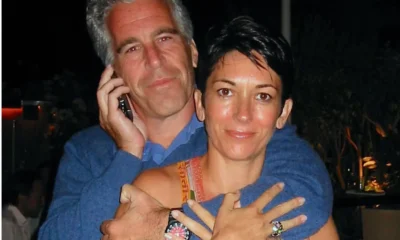Entertainment
George Clooney and More Stars Match the Rock’s $1 Million SAG Donation on August 2, 2023 at 8:42 pm Us Weekly

George Clooney, Ryan Reynolds, Blake Lively and Dwayne Johnson Shutterstock (4)
More Hollywood A-listers are matching Dwayne The Rock” Johnson’s $1 million donation to the SAG-AFTRA fund, more Hollywood A-listers are following suit.
“The entertainment industry is in crisis and the SAG-AFTRA Foundation is currently processing more than 30 times our usual number of applications for emergency aid. We received 400 applications in the last week alone,” SAG-AFTRA Foundation president Courtney B. Vance told Variety in a Wednesday, August 2, statement about the nonprofit’s successful fundraising efforts. “It’s a massive challenge, but we’re determined to meet this moment.”
Since the actors’ guild officially went on strike last month, the SAG Foundation has raised more than $15 million for its emergency financial assistance program — greatly in part to some of Hollywood’s top-earning actors. Among those who have donated are George and Amal Clooney, Luciana Barroso and Matt Damon, Leonardo DiCaprio, Hugh Jackman and Deborra-Lee Furness, Nicole Kidman, Jennifer Lopez and Ben Affleck, Ryan Reynolds and Blake Lively, Julia Roberts, Arnold Schwarzenegger and Meryl Streep.
Celebrities are following in the footsteps of Johnson, 51, who recently contributed a seven-figure amount to the organization, which can deliver grants of up to $1,500 per member. (In other cases, a lifetime union member could receive up to $6,000 in emergency assistance if in serious jeopardy.) At the time, the foundation’s executive director, Cyd Wilson, told Variety that Johnson’s donation was the “largest single donation” the organization has ever received from one person.
“I appealed to our community to remember how tough it was coming up, and the response to help their fellow performers has been incredible, immediate and heartwarming,” Vance continued in his statement on Wednesday, noting that Johnson, 51, “helped kick-start this campaign.” He also gave thanks to Streep, 74, and George, 62, who “stepped up with $1 million donations, emails and many calls-to-action rallying others to give generously.”
Vance announced that thanks to the latest donations, the SAG Foundation has “crushed our initial goal” — but the work still isn’t done. “Our fundraising will continue in order to meet the overwhelming needs of our community now and in the future,” he concluded.
“I remember my days as a waiter, cleaner, typist, even my time on the unemployment line,” Streep told Variety on Wednesday, detailing why it’s important for her to give back. “In this strike action, I am lucky to be able to support those who will struggle in a long action to sustain against Goliath. We will stand strong together against these powerful corporations who are bent on taking the humanity, the human dignity, even the human out of our profession. I am proudest of my fellow actors who have immediately offered to fund the Emergency Financial Assistance Program.”
George, for his part, released his own statement on July 13 before the strike began. “We stand ready to get back to the table and make a fair deal with the AMPTP,” he said. “Until then, I’m proud to be able to support the SAG-AFTRA Foundation and my fellow actors who may be struggling in this historic moment. We’ve stood on the shoulders of the likes of Bette Davis and Jimmy Cagney and it’s time for our generation to give something back.”
He thanked Vance in particular for “his determination in putting this effort together by shedding light on the human toll happening right now, and how we can work together to alleviate some of the pain and suffering” from those currently struggling without work.
The Screen Actors Guild – American Federation of Television and Radio Artists (SAG-AFTRA) has been on strike since July 14 over an ongoing dispute with the Alliance of Motion Picture and Television Producers (AMPTP). The guild’s issues are regarding fairer wages, streaming residuals, artificial intelligence and other topics that could not be agreed upon by the AMPTP when drawing up a new contract.
SAG members took to the picket lines two months after the Writers Guild of America (WGA) went on its own strike over similar disputes with the AMPTP. It marks the first time that both the actors and writers unions have been on strike together since 1960.
Beyond large donations, many celebrities have found their own ways to show their solidarity for both strikes, by either picketing outside New York City and Los Angeles-based studios or getting candid about their experiences in the industry.
Mandy Moore, who starred as Rebecca Pearson for six seasons on the critically acclaimed show This Is Us, explained during an interview with The Hollywood Reporter last month that actors could be surviving on residuals between projects if they are paid fairly — but that’s not typically the case.
“We’re in incredibly fortunate positions as working actors having been on shows that found tremendous success in one way or another … but many actors in our position for years before us were able to live off of residuals or at least pay their bills,” she told the outlet, adding that she received “very tiny, like, 81-cent checks” for streaming residuals for the NBC hit.
Robert Carradine, who starred on Lizzie McGuire alongside Hilary Duff, brought his own receipts in support of the strike, sharing a photo via Instagram last week that revealed he earned “$0.00” in residuals for the show in August 2019, despite the entire series being available to stream on Disney+
More Hollywood A-listers are matching Dwayne The Rock” Johnson’s $1 million donation to the SAG-AFTRA fund, more Hollywood A-listers are following suit. “The entertainment industry is in crisis and the SAG-AFTRA Foundation is currently processing more than 30 times our usual number of applications for emergency aid. We received 400 applications in the last week
Us Weekly Read More
Entertainment
What We Can Learn Inside 50 Cent’s Explosive Diddy Documentary: 5 Reasons You Should Watch

50 Cent’s new Netflix docuseries about Sean “Diddy” Combs is more than a headline-grabbing exposé; it is a meticulous breakdown of how power, celebrity, and silence can collide in the entertainment industry.
Across its episodes, the series traces Diddy’s rise, the allegations that followed him for years, and the shocking footage and testimonies now forcing a wider cultural reckoning.

1. It Chronicles Diddy’s Rise and Fall – And How Power Warps Reality
The docuseries follows Combs from hitmaker and business icon to a figure facing serious criminal conviction and public disgrace, mapping out decades of influence, branding, and behind-the-scenes behavior. Watching that arc shows how money, fame, and industry relationships can shield someone from scrutiny and delay accountability, even as disturbing accusations accumulate.

2. Never-Before-Seen Footage Shows How Narratives Are Managed
Exclusive footage of Diddy in private settings and in the tense days around his legal troubles reveals how carefully celebrity narratives are shaped, even in crisis.
Viewers can learn to question polished statements and recognize that what looks spontaneous in public is often the result of strategy, damage control, and legal calculation.
3. Survivors’ Stories Highlight Patterns of Abuse and Silence
Interviews with alleged victims, former staff, and industry insiders describe patterns of control, fear, and emotional or physical harm that were long whispered about but rarely aired in this detail. Their stories underline how difficult it is to speak out against a powerful figure, teaching viewers why many survivors delay disclosure and why consistent patterns across multiple accounts matter.
4. 50 Cent’s Approach Shows Storytelling as a Tool for Accountability
As executive producer, 50 Cent uses his reputation and platform to push a project that leans into uncomfortable truths rather than protecting industry relationships. The series demonstrates how documentary storytelling can challenge established power structures, elevate marginalized voices, and pressure institutions to respond when traditional systems have failed.
5. The Cultural Backlash Reveals How Society Handles Celebrity Accountability
Reactions to the doc—ranging from people calling it necessary and brave to others dismissing it as a vendetta or smear campaign—expose how emotionally invested audiences can be in defending or condemning a famous figure. Watching that debate unfold helps viewers see how fandom, nostalgia, and bias influence who is believed, and why conversations about “cancel culture” often mask deeper questions about justice and who is considered too powerful to fall.
Entertainment
South Park’s Christmas Episode Delivers the Antichrist

A new Christmas-themed episode of South Park is scheduled to air with a central plot in which Satan is depicted as preparing for the birth of an Antichrist figure. The premise extends a season-long narrative arc that has involved Satan, Donald Trump, and apocalyptic rhetoric, positioning this holiday episode as a culmination of those storylines rather than a stand‑alone concept.
Episode premise and season context
According to published synopses and entertainment coverage, the episode frames the Antichrist as part of a fictional storyline that blends religious symbolism with commentary on politics, media, and cultural fear. This follows earlier Season 28 episodes that introduced ideas about Trump fathering an Antichrist child and tech billionaire Peter Thiel obsessing over prophecy and end‑times narratives. The Christmas setting is presented as a contrast to the darker themes, reflecting the series’ pattern of pairing holiday imagery with controversial subject matter.
Public and political reactions
Coverage notes that some figures connected to Donald Trump’s political orbit have criticized the season’s portrayal of Trump and his allies, describing the show as relying on shock tactics rather than substantive critique. Commentators highlight that these objections are directed more at the depiction of real political figures and the show’s tone than at the specific theology of the Antichrist storyline.
At the time of reporting, there have not been widely reported, detailed statements from major religious leaders focused solely on this Christmas episode, though religion-focused criticism of South Park in general has a long history.
Media and cultural commentary
Entertainment outlets such as The Hollywood Reporter, Entertainment Weekly, Forbes, Slate, and USA Today describe the Antichrist arc as part of South Park’s ongoing use of Trump-era and tech-world politics as material for satire.
Viewer guidance and content advisory
South Park is rated TV‑MA and is intended for adult audiences due to strong language, explicit themes, and frequent use of religious and political satire. Viewers who are sensitive to depictions of Satan, the Antichrist, or parodies involving real political figures may find this episode particularly objectionable, while others may view it as consistent with the show’s long‑running approach to controversial topics. As with previous episodes, individual responses are likely to vary widely, and the episode is best understood as part of an ongoing satirical series rather than a factual or theological statement.
Entertainment
Sydney Sweeney Finally Confronts the Plastic Surgery Rumors

Sydney Sweeney has decided she is finished watching strangers on the internet treat her face like a forensic project. After years of side‑by‑side screenshots, “then vs now” TikToks, and long comment threads wondering what work she has supposedly had done, the actor is now addressing the plastic surgery rumors directly—and using them to say something larger about how women are looked at in Hollywood and online.

Growing Up on Camera vs. “Before and After” Culture
Sweeney points out that people are often mistaking normal changes for procedures: she grew up on camera, her roles now come with big‑budget glam teams, and her body has shifted as she has trained, aged, and worked nonstop. Yet every new red‑carpet photo gets folded into a narrative that assumes surgeons, not time, are responsible. Rather than walking through a checklist of what is “real,” she emphasizes how bizarre it is that internet detectives comb through pores, noses, and jawlines as if they are owed an explanation for every contour of a woman’s face.
The Real Problem Isn’t Her Face
By speaking up, Sweeney is redirecting the conversation away from her features and toward the culture that obsesses over them.
She argues that the real issue isn’t whether an actress has had work done, but why audiences feel so entitled to dissect her body as public property in the first place.
For her, the constant speculation is less about curiosity and more about control—another way to tell women what they should look like and punish them when they do not fit. In calling out that dynamic, Sweeney isn’t just defending herself; she is forcing fans and followers to ask why tearing apart someone else’s appearance has become such a popular form of entertainment.

 Entertainment2 weeks ago
Entertainment2 weeks agoWicked Sequel Disappoints Fans: Audience Verdict on For Good

 News3 weeks ago
News3 weeks agoYolanda Adams Questions Traditional Views on God’s Gender, Audience Reacts

 Entertainment2 weeks ago
Entertainment2 weeks agoAriana & Cynthia Say They’re in a ‘Non‑Demi Curious, Semi‑Binary’ Relationship… WTF Does That Even Mean?

 News3 weeks ago
News3 weeks agoEpstein Files to Be Declassified After Trump Order

 News4 weeks ago
News4 weeks agoTrump Throws Epstein Files at Clinton’s Door

 Entertainment4 weeks ago
Entertainment4 weeks agoAriana Grande’s Red Carpet: When Fans Forget Boundaries

 Entertainment3 weeks ago
Entertainment3 weeks agoHollywood’s Kiss or Miss Policy: Why Saying No Got Neal McDonough Blackballed

 Entertainment3 weeks ago
Entertainment3 weeks agoJimmy Cliff, Reggae Legend and Star of ‘The Harder They Come,’ Dies at 81


























